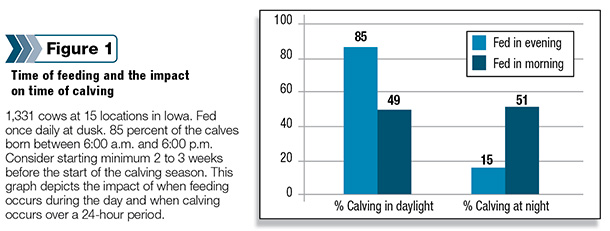Long hours, not enough labor and Mother Nature are only a few items that come to mind. A simple management strategy can increase the number of cows calving during the daytime when a cow that is calving can be quickly seen and, if needed, tended to.
The easiest and most practical method of inhibiting nighttime calving at present is by feeding cows at night; the physiological mechanism is unknown, but some hormonal effect may be involved.

Rumen motility studies indicate the frequency of rumen contractions falls a few hours before parturition. Intraruminal pressure begins to fall in the last two weeks of gestation, with a more rapid decline during calving.
It has been suggested that night feeding causes intraruminal pressures to rise at night and decline in the daytime.
There are some nice data sets that support that feeding pregnant cows at dusk will increase the number of cows calving during the daytime.
In a Canadian study of 104 Hereford cows, 38.4 percent of a group fed at 8:00 a.m. and again at 3:00 p.m. delivered calves during the day as compared to 79.6 percent of a group fed at 11:00 a.m. and 9:00 p.m.
A British study utilizing 162 cattle on four farms compared the percentages of calves born from 5:00 a.m. to 10:00 p.m. to cows fed at different times. When cattle were fed at 9:00 a.m., 57 percent of the calves were born during the day compared to 79 percent when feeding occurred at 10:00 p.m.
In field trials by cattlemen utilizing night feeding when 35 cows and heifers were fed once daily between 5:00 p.m. and 7:00 p.m., 74.5 percent of the calves were born between 5:00 a.m. and 5:00 p.m.
In the most convincing study to date, 1,331 cows on 15 farms in Iowa were fed once daily at dusk, and 85 percent of the calves were born between 6:00 a.m. and 6:00 p.m.
Whether cows were started on the night feeding the week before calving started in the herd or two to three weeks earlier made no apparent difference in calving time.
The graph illustration (Shown above) is of the data collected on farms and depicts the impact of when feeding occurs during the day and when calving occurs over a 24-hour period. ![]()
Rick Rasby is a beef specialist with the University of Nebraska – Lincoln
—Excerpts from University of Nebraska – Lincoln BeefWatch






